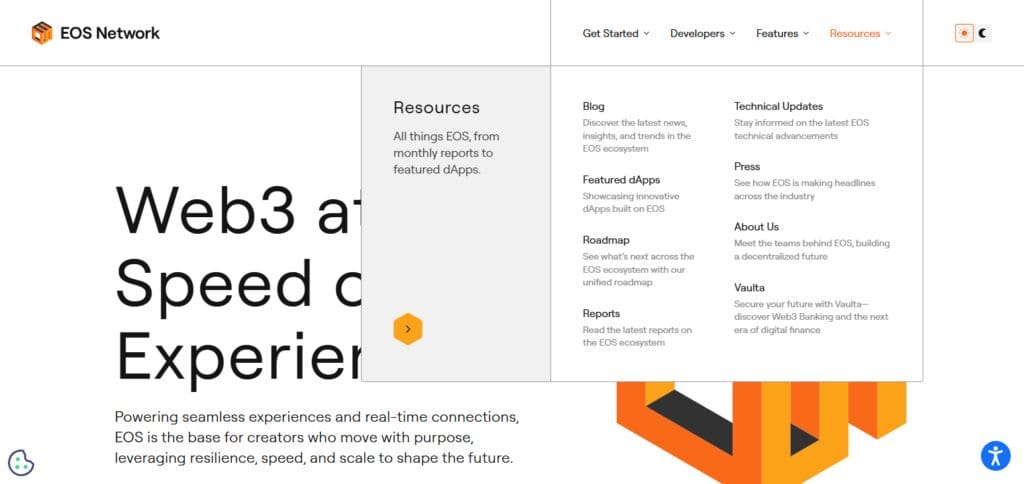In this Article, I will discuss the Eos Blockchain Pros And Cons, focusing on its advantages and disadvantages.
The benefits of EOS are its high scalability, zero transaction fee, and energy efficiency, which makes it appealing for dApp development.
It also suffers from centralization worries, governance issues, and resource expenditures. Keeping these elements in mind enables you to assess if EOS suits your requirements.
What is EOS Blockchain?
EOS serves as a decentralized application (Dapps) hosting, development, and execution platform. EOS was launched in 2018 by Block.one and uses the Delegated Proof-of-Stake (DPoS) consensus mechanism which enables faster transactions as token holders vote block producers.

EOS is useful to applications that require fast processing, like dApps, thanks to the high throughput it offers alongside feeless transaction capabilities. Furthermore, eos has added functionality for smart contracts and supports various programming languages.
Despite having multiple advantages, EOS has faced criticism due to concerns of limited block producers leading to increased centralization.
Features of EOS Blockchain
Scalability
EOS can outperform other cryptocurrencies like Bitcoin and PayPal when it comes to transactions per second. This growth in efficiency is made possible by the adoption of Delegated Proof-of-Stake (DPoS). This new mechanism allows EOS to scale beyond its current capacity of thousands of transactions per second allowing it to potentially handle millions in the future.
Flexible Permission System
A unique feature of EOS blockchain is its customizable permisions structure. This particular framework gives users the flexibility to set unique authorizations for each business case which enhances security. For instance, you can set critical permissions within an EOS smart contract.
Upgradability
Since dApps are fully upgradeable, developers can now fix bugs or update outdated and flawed codes easier than before. This new feature, offered by EOS, allows developers to add new application logic along with code patches if needed offering easier means of continuous improvement.
Energy Efficiency
EOS is significantly more sustainable than other cryptocurrencies due to the adoption of DPoS. Compared to Power-of-Work (PoW) blockchains such as Bitcoin, EOS consumes less energy making it more eco friendly.
On-Chain Governance
EOS uses governance through its constitution which is hashed and stored with each transaction. This associates users to the network’s governing rules which makes users accountable and compliant to regulations.
Decentralized Operating System
Similar to a decentralized organization, EOS operates as an OS at a lower infrastructure level. Decentralized blockchains that target business applications provide comprehensive functionalities. EOS has resources and tools that ensure ease in developing and deploying dApps which makes it user-friendly.
10 Eos Blockchain Pros And Cons
Pros of EOS Blockchain
1. High Scalability: EOS can process thousands of transactions every second thanks to its usage of Delegated Proof-of-Stake (DPoS).
2. No Transaction Fees: Users, as well as dApp developers, find it appealing because they do not incur a fee for any transactions undertaken.
3. Energy Efficiency: With the absence of Proof-of-Work (PoW) blockchains, EOS is considered environmentally friendly due to its lower energy consumption.
4. Friendly User Development: Accessibility is enhanced for developers because EOS supports various programming languages such as C++ and Python.
5. Flexible and Upgradeable dApps: The changes made by developers to the dApps on the platform do not necessitate a hard fork, hence the platform is adaptable.
6. Customizable Permission System: Specific security measures can be set for various operations, thanks to advanced permission control provided by EOS.
7. On-Chain Governance: Transparency and accountability are encouraged by having built governance in the form of a constitution on the platform.
8. Decentralized Operating System: EOS provides authentication, cloud storage, and server hosting, to mention a few, just like an operating system.
9. Interoperability: Block communication is made possible by EOS making its usage versatile.
10. Large dApp Ecosystem: EOS is widely adopted and used by an increasing number of dApps, which improves its functionality.
Cons of EOS Blockchain
1. Centralization Concerns: The usage of DPoS raises fears of centralization due to its dependence on a small group of block producers.
2. Block Producer Influence: Governance and collusion manipulation can arise due to the limited number of block producers.
3. Decentralization Flaw: EOS claims to be decentralized but it uses a governance model that is fundamentally semi-centralized.
4. Resource Price (RAM): Developers are required to buy RAM in order to host dApps, which could be very costly.
5. Governance Model is Complicated: The constitution and voting enabled on the chain are hard to comprehend for an average beginner.
6. Lack of Acceptance: Even after gaining some popularity, EOS is still way behind other platforms such as Ethereum in adoption and market share.
7. DApp Security Risks: Weaknesses in dApp coding can leave the network vulnerable to attacks.
8. Block.one Reliance: There are concerns that EOS might be overly centralized due to its association with the founding company.
9. Less Innovation: The speed of growth of this platform has lagged behind that of other platforms, which has stifled innovation.
10. Compliance and other Risk Factors: EOS had legal trouble, such as having to settle for $24 million with the SEC regarding their ICO due to not registering it.
Founders of EOS Blockchain
Designed by Block.one, the EOS white paper was drafted by Daniel Larimer and Brendan Blumer.
Both men serve as members of Block.one’s staff, with Blumer serving as CEO and Daniel Larimer assuming the role of CTO.
Blumer could be a serial entrepreneur, and among his earliest ventures was trading virtual assets for video games. He later went on to co-found Okay.com, a real estate brokerage based out of Hong Kong that specializes in technology.
Larimer is a computer engineer who has set out to accomplish a number of crypto endeavors. They include the cryptocurrency trading platform BitShares and the Steem blockchain.
The duo first met in 2016 and established Block.one the following year.
Economy of EOS Blockchain
Instead of relying on mining like Bitcoin, EOS creates new currency through block production, which earns producers EOS tokens. Block producers have the option to claim whatever amount they want as payment.
In order to avoid abuse, the system does place a cap on the portion of tokens a producer can claim annually. This ensures the total token supply only increases by 5% a year. Thus, token holders have the ability to vote and prevent unreasonable demands by block makers.
Consequently, EOS tokens can be stored in multiple wallets and traded on numerous cryptocurrency exchanges. The creation of blocks, however, is still done in a central manner which differentiates from the overall concept of blockchain decentralization. Because of this, they have faced a significant amount of backlash.
Future Scope of EOS Blockchain
Interoperable with Other Chains:
EOS is anticipated to expand its cross-chain features to seamlessly include Ethereum and Bitcoin, thereby making it more versatile.
Enhanced Scalability and Speed
EOS intends to increase its transaction throughput even further beyond two thousand TPS. This makes it ideal for large-scale dApps, DeFi platforms and enterprise solutions.
Adoption of Eco-Friendly Blockchain
As energy efficiency gains even more importance EOS becomes more suitable for green blockchain projects due to its low energy consumption from Dpos.
Expanding DeFi and NFT Ecosystem
Due to its feeless, fast processing, EOS would be a go-to platform on which a boosted adoption of DeFi protocols and NFT marketplaces can be created.
Governance Model Improvement
EOS could refine its on-chain governance model to make it less centralized which would provide more transparency to the community.
Widespread Business Use
EOS’s scalability and other business-centric features makes it suited for use by big corporates for supply chain management, data storage and finance related applications.
Attraction of New Projects with EOS EVM (Ethereum Virtual Machine)
The release of EOS EVM increases the ease with which Ethereum developers can build on EOS leading to improved interoperability and more projects coming in.
Implementing Upgrades and Shrinking Solutions
EOS will probably implement layer two solutions or sharding to increase scalability and efficiency.
Scaling dApp Development
Because of its rapid processing speeds as well as the absence of fees, EOS can potentially become a leading choice for dApps such as e-commerce, social media, and gaming.
Enhanced Participation from Developers and the Community
Continued work along with partnerships and community enhancement may improve the long-term sustainability and position of EOS in the blockchain ecosystem.
Conclusion
The blockchain platform that is best suited for dApps, DeFi, and big scale applications is EOS because it is energy-efficient, fast, and scalable. Its upgradeable dApps, and flexible permissions system, along with fee-less transactions, make it quite cost-effective and user-friendly. Issues over centralization, complexity in governance, and resource expenditures prove daunting, however.
Overall, EOS has many promising benefits that show the likelihood of cross-chain compatibility, enterprise adoption, and growth in DeFi’s prominence. It remains to be seen how well the platform tackles its centralization challenges, along with continuously improving scalability and security, which will determine its future success.










